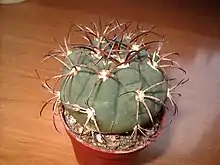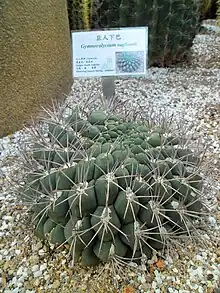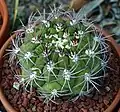| Gymnocalycium saglionis | |
|---|---|
 | |
| Spines are recurved | |
 | |
| Large, mature Gymnocalycium saglionis in Hong Kong Park | |
| Scientific classification | |
| Kingdom: | Plantae |
| Clade: | Tracheophytes |
| Clade: | Angiosperms |
| Clade: | Eudicots |
| Order: | Caryophyllales |
| Family: | Cactaceae |
| Subfamily: | Cactoideae |
| Genus: | Gymnocalycium |
| Species: | G. saglionis |
| Binomial name | |
| Gymnocalycium saglionis | |
| Synonyms[2] | |
|
List
| |
Gymnocalycium saglionis, the giant chin cactus, is a globular cactus species endemic to northwest Argentina.
The cacti's most common native habitats are withinin the Argentine provinces of Salta, Tucuman, Catamarca, San Juan, and La Rioja. It grows on rocky soil with other low vegetation.
Description
Named after J. Saglio, an important plant collector in France around 1840, Gymnocalycium saglionis is known to grow very slowly, and grow best in warm and part shady conditions, but tolerate extremely bright situations although they are likely to suffer from sun scorch or stunted growth if over exposed to direct sunlight during the hottest part of the day in summer.
The body can range from dull-green or blue-green, almost cylindrical more or less flattened up to 40 cm in diameter, up to 90 cm tall. Spines can grown to 3−4 cm long, colors varies from yellowish-brown, reddish or white becoming grey with time which contrast well against the green body, 1−3 centrals and 10−15 radials bent against the stem.
Spines become bright red when wet.
Flowers 1.4 inch (3.5 cm) long, white or reddish, often more than one simultaneously. Fruits globular, reddish or dark pink, splits sideways with tiny, shiny black brown seeds.
Cultivation
Gymnocalycium saglionis is cultivated as an ornamental plant around the world, and is commonly for sale.[3][4] Plants are large and have thick curved spines making this species popular among collectors.
In the UK it has gained the Royal Horticultural Society's Award of Garden Merit.[5]
Gallery
 Young plant
Young plant Young plants
Young plants Plant with flower.
Plant with flower. Flowers - details
Flowers - details Plant with two ripe fruits
Plant with two ripe fruits Fruit cracking open
Fruit cracking open
References
- ↑ "The IUCN Red List of Threatened Species". IUCN Red List of Threatened Species. 2010-09-21. Retrieved 2023-12-08.
- ↑ "Gymnocalycium saglionis (Cels) Britton & Rose". Plants of the World Online. Board of Trustees of the Royal Botanic Gardens, Kew. Retrieved 14 May 2021.
- ↑ "Gymnocalycium saglionis forma cristata".
- ↑ http://www.kakteensammlung-holzheu.de/en/gymnocalycium_saglionis.html
- ↑ "Gymnocalycium saglionis". www.rhs.org. Royal Horticultural Society. Retrieved 16 July 2020.
